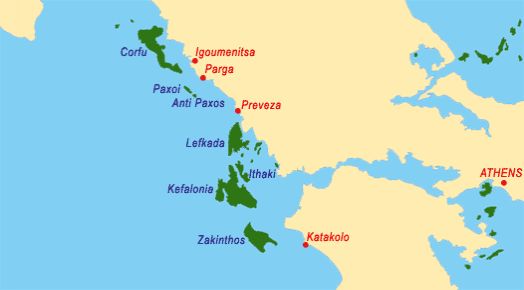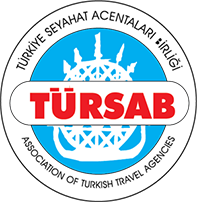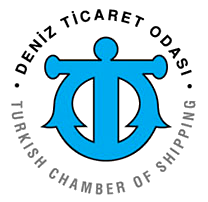Greek Islands & Ionian
Greece - Greek Islands & Itineraries |
 IONIAN GI-1 Corfu - Corfu Ionian ( 1 week )
GI-2 Corfu - Corfu Ionian ( 2 weeks )
PLACES TO SEE IN IONIAN ISLANDS
Corfu The capital of the island is also called Corfu (Kerkira). It is built on a promontory that projects into the sea and is separated into a northern and a southern section. East of the northern part lies the Old Fortress, cut off from the town by a moat. For centuries all the popular of Corfu lived within this citadel, which was founded by the Byzantines but greatly expanded and strengthened by the Venetians. The town of Corfu is made up of completely dissimilar elements, left over from different civilizations. It presents an enchanting picture with its broad streets and spacious squares, the popular Spianada – the town "green" – contrasting with its narrow back alleys paved with blocks of stone (known as "Kantounia"), houses with a strong Italian influence, the famous Liston, a French arcade, traditional Georgian mansions, a Byzantine church, Venetian monuments, balconies with wrought-iron railings and window grilles.
Paxoi Another advantage are the beautiful, safe ports in Paxi , where a great number of boats can be gathered at any one time.
Ithaki The west side of the island is steep and bare in contrast withthe east which is verdant and slopes gently down to the sea. The visitor can go on excurtions to the intesely Ionian, traditional seaside villages, and visit the medieval monastery of Taxiarhon and the wonderful caves of the island that are just begging to be explored. Ithaka is a very loved place, with scenic beaches, sleepy little villages and an ideal spot for an unforgettable vacation.
Kefalonia Argostoli – Until 1953 Argostoli was ver much like Fiscardo, due to the earthquake the town was rebuilt. Some remains show what the capital was like. You can get water and fuel on the quay, provisions are in an abundance. You can tie on the quay but might opt for the cove on the east side near the entrance but this is recommended only in calm weather. Lixouri – Across the gulf from Argostoli is Lixouri. The prevailing NW winds can make anchoring uncomfortable. Fuel and water can be obtained. Fiscardo The north east village of the island and the only one that survived during the 1953 earthquakes. Fiskardo is considered as one of the most traditional villages in Europe due to its architecture and all the traditions that it carries. Cosmopolitan surroundings, luxurious shops, beautiful bars and food for all tastes and ages is what Fiskardo has to offer its visitors. The beachside restaurants, tavernas and bars which you will find situated side by side, are decorated with beautifully glowing lit candies which give you the colour of festivity at its best. Walk along the beautiful pathways of the village and witness the Ionian beauty at its best. Take a swim in the ever enchanting beaches of Emblisi, Foki and Andrea limani. Join the hustle and bustle of Fiscardo, a picturesque bay where you can find the best food in the famous "Captain's Bar" that serves the best food in the area. Poros – A small harbor with winds from the north. Fuel and water can be obtained. If you are the adventurous type a walk to gorge is quite a spectacular site.
Lefkas · Lefkas Town - The harbor offers good shelter as well as facilities. Care must be taken when entering and leaving the harbor not to cut across the corner of the canal east of the town when arriving or leaving from South. The depths are only ½ a meter. · Nidri – It can get a bit crowed as it is a yacht charter center where several flotillas start from. It is a quaint town which offers good shelter. You can provision your yacht with fuel, water, food and any repairs. There are several tavernas to choose from. · Tranquil Bay – This bay is located opposite of Nidri town, The bay provides good shelter and an impressive beauty with its olive and cypress trees surrounding the bay. It offer tranquility as name states. · Ormos Vlikho – There is a small quay and the bay itself offers good shelter. The prevailing winds here are northerly . Some provisions are available in town and there are several tavernas.
Zakynthos No one who has been here can forget the emerald green of its sea, its pine-studded mountains, its musical people and their hospitality. The first thing to welcome you, as soon as you step off the ferryboat, is the town of Zakinthos. Though it lost all but three of its buildings in the earthquake of 1953, the town has been meticulously reconstructed and its former layout has been faithfully preserved. Zakinthos today has pleasantly arcaded wide streets, spacious squares imposing buildings and cheerful houses. The Museum of Post-Byzantine Art on Solomos Square contains treasures salvaged from the island's historic churches. On the waterfront, one should visit the churches of Agios Dionysios, the island's patron saint, with its tall campanile, and of Agios Nikolas tou Molou, a church out of the Italian Renaissance with, surprisingly, a 17th century Byzantine belfry. Zakynthos is almost triangular in shape, with two green mountainous promontories extending into the sea to form the huge bay of Laganas. There are more pine-covered mountains and hills in the north, but the centre is gentle and lush, richly planted with currant vines, olive trees, almonds and seasonal vegetables. There are dozens of beaches to choose from, sandy and sheltered with invitingly sparkling water. Flowers of every kind till every available space, filling the air with the scent that so enraptured visitors of old. With a sunny climate most of the year and good roads to facilitate exploring, Zakinthos lends itself to holiday making in spring and fall as well as summer. Some of the best known summer resorts are Argassi, Alikes, Planos, Tsilivi, Vassilikos, Gerakas and Porto Roma, while Laganas is the most famous of all. Its long beach and wide range of facilities attract thousands of tourists from May through September. At Laganas, Vassilikos and Gerakas, the endangered sea turtle "Caretta-Caretta" also comes to lay her eggs. |
|








